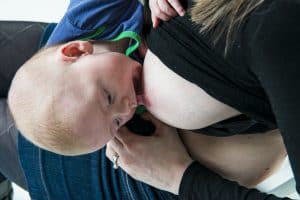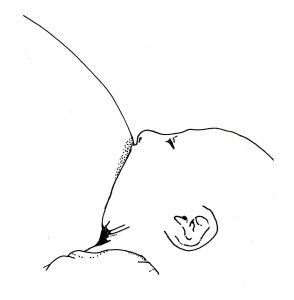Getting Started
Breastfeeding should be COMFORTABLE
How you sit (or lie down) and how close you hold your baby as you feed can make a difference to how well things go. Sometimes a little difference in how your baby is feeding can make a big difference to how comfortable it is for you and how easily your baby gets your milk.
Breastfeeding should NOT HURT
Changing how you hold your baby and how they start to feed can sometimes make a difference to how they settle after feeds.
How you hold your baby is frequently called positioning.
How your baby takes the breast is sometimes called attaching or latching.
Positioning can help make ATTACHMENT more effective and comfortable, here’s how:
Your baby needs to be able to take a large mouthful of breast and feed effectively without causing you any discomfort.
Especially in the early days, you may find it more comfortable to feed lying in a semi reclined position, with your body and head completely supported. In this position your baby feeds while lying on your stomach with their legs bent at the knee. This way your baby can move towards your nipple and breast themselves, with some gentle guidance if needed. Alternatively, you may prefer to breastfeed sitting up with your baby lying across your body or in a rugby hold.
- Sit comfortably with your back well supported and your feet flat on the floor or raised on a stool or box so that your lap is flat.
- Keep your baby’s body in a straight line with their whole body facing and touching you.
- Support your baby’s neck, shoulders and back, but avoid touching their head, so that they can tilt their head back easily.
- Move your baby from your cleavage towards your nipple.
- Make sure your baby’s lower lip and chin is in contact with your breast first.



Signs of Effective Attachment

- Your baby has a large mouthful of breast.
- Your baby’s chin is firmly touching your breast.
- Your baby’s mouth is wide open.
- If you can see the dark skin around your nipple, you should see more dark skin above your baby’s top lip than below your baby’s bottom lip.
- It doesn’t hurt you when your baby feeds (although the first few sucks may feel strong).
- No change in shape or colour of your nipple after feeds e.g should not be lipstick shaped or have lines across the nipple.
- Your baby’s cheeks stay rounded during sucking.
- Your baby rhythmically takes long sucks and swallows (it is normal for your baby to pause from time to time).
- Your baby finishes the feed and comes off the breast on his or her own.
- You can hear and see your baby swallowing the milk although there will be pauses.
- Baby produces regular soaked/heavy nappies; bowel motions (poo) should be soft and yellow from day 4/5 with 2 or more dirty nappies a day with poos at least the size of a £2 coin.
- From about 6 weeks the amount of poo varies from day to day, often with larger amounts. Your baby may not poo every day. You will get to know your baby’s pattern.
The following issues are possible signs that your attachment could benefit from being altered. They are not always caused by attachment, but it is worth trying to adjust the way you are holding your baby and bringing them to the breast before considering any other explanations:
- Baby starts to feed then pulls away
- Nipples cracked or sore
- Baby is unsettled or ‘colicky’
- Breasts leak
- Baby fights or refuses the breast
- Baby wakes up frequently in the night
- Baby has sore bottom, watery stools or green poo
- Slow weight gain
- Blocked ducts or mastitis
- Baby’s nose is blocked by mother’s breast
- Very frequent and/or lengthy feeds
There are some illustrations and more information in Off to the Best Start.
If you want to talk through positioning and attaching in more detail, you could contact the National Breastfeeding Helpline to speak to a registered Breastfeeding Supporter. The National Breastfeeding Helpline is available 24 hours a day, 365 days a year, on 0300 100 0212, or via social media from 9:30am to 9:30pm. Webchat is also available.
Here are some links to external breastfeeding websites with line drawings and images that give tips on how to get your baby to the breast correctly:
- When Latching by Jack Newman MD, FRCPC, IBCLC and Edith Kernerman IBCLC
- Jack Newman’s Website and video clips
- NHS breastfeeding website
- UNICEF Baby Friendly Initiative Information booklets (with images) to download
- ParentClub Scotland feeding Information Including information about hand expressing
Speak to a registered Breastfeeding Supporter
The National Breastfeeding Helpline is available
24 hours a day, 365 days a year. Or talk to us by webchat when available.

